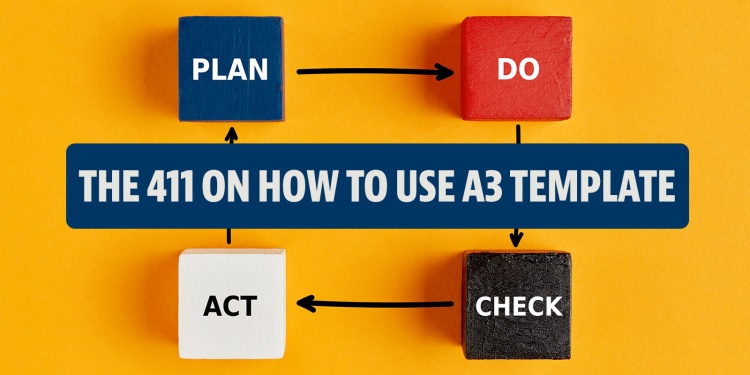
A3 is a versatile problem-solving method and continuous improvement tool. It’s called A3 because it fits on a standard sheet of paper. Download our free A3 template and you’ll have everything you need to get started.
Why to Use A3
A3 is a step-by-step approach for applying plan-do-check-act, also known as PDCA or the Deming cycle. PDCA is a Lean technique that has proven effective in driving productivity and efficiency across industries and around the world. With PDCA, you identify the problem, assess the current state, and create a Plan to solve the problem and gauge success. In the Do phase, you test the plan by running an implementation pilot. Next, you Check and analyze the results of the pilot against the objectives identified in the plan. If things didn’t turn out as you hoped, you cycle back to the plan phase and adjust your approach. If everything looks good, you Act by implementing the plan on a larger scale.
As you can imagine, it’s easy to get overwhelmed by PDCA. The model itself is simple enough, but teams are often unsure when to move from one step to the next (or, back to a prior step). PDCA can also generate a ton of data and analysis that teams struggle to sift through.
A3 streamlines and visualizes PDCA, which makes it a lot easier for teams to make quick decisions. It’s hard to get lost or confused when everything is on one sheet of paper.
When to Use an A3
A3 is a good fit for:
- complex problems,
- cross-functional improvement initiatives (e.g., end-to-end process improvement),
- strategy development,
- communicating project status reports, and
- building the critical thinking and problem-solving capabilities of a team.
Not all business problems require an A3. If you’re faced with a simple problem that has a known cause, just go solve it! But if you have a more challenging issue to tackle, pull out the A3.
How to Fill Out an A3
For best results, the A3 should be filled out collaboratively in a workshop format. The amount of time required depends on the scope of the problem and stakeholders’ schedules, but the process of filling out an A3 can generally be done in a series of three workshops.
Gather stakeholders together and provide each with their own copy of page 2 of APQC’s A3 template. Replicate page 1 of the template on a whiteboard. To get participants into a Lean mindset, open the session by walking through the eight types of waste on page 3. Now, you are ready to begin filling out the template together.
- Define the problem statement. Collaboratively determine what problem needs to be solved and how it impacts the business and its customers. At this stage, the problem statement will be a bit “fuzzy,” and that’s OK.
- Understand the current state. Explore the current state around the problem to assess its impact and potential causes (including the eight types of waste). Bring data into the discussion where possible, but don’t go too far into the weeds just yet.
- Identify an improvement opportunity and business benefits. Write down how solving the problem would help in achieving business goals and KPIs. Be as specific as possible.
- Determine the root cause. Now, it’s time to really dig into the data around the problem. Look closely at all potential causes as well as upstream and downstream relationships that could impact potential solutions.
- Identify solutions and a future-state vision. Discuss potential solutions and what the future might look like if they were implemented.
- Build an implementation plan. Define what needs to happen, who will do it (resources), and how they will do it (training, if necessary).
- Verify results. Examine the results of implementation to determine whether desired results were achieved.
- Follow-up. If the implementation results were positive, define actions necessary to expand and/or sustain the implementation. If the implementation did not go well, revisit everything you’ve documented in the template thus far to assess what went wrong. For example:
- Did you miss some aspects of the current state (e.g., undocumented variations, exceptions, or workarounds)?
- Did you misinterpret the root cause?
- Do you need to do a better job of articulating business benefits and a future state vision build buy-in?
Making A3 Work for Your Company
You can purchase A3 modeling software, but it’s not necessary and it’s definitely not a silver bullet. The keys to success with A3 are training, facilitation, and data availability. You get the best results when participants have a foundational understanding of Lean, are supported by a strong facilitator, and have easy access to relevant information.
For more templates like this, see APQC’s collection of Benchmarking and Improvement Tools.